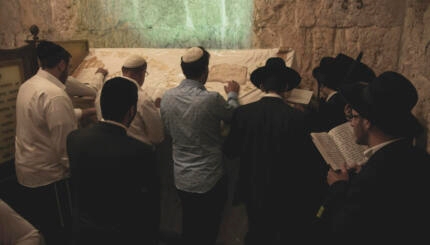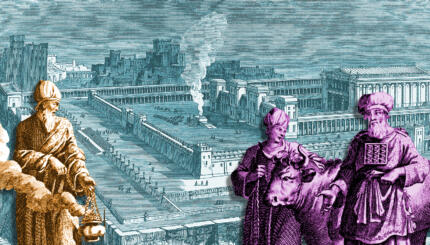The Inquisition Creeps Outwards from Andalusia
Once it had proved its efficacy in Andalusia, the Inquisition was extended step-by-step into the towns of central Castile, including Toledo and Ciudad Real. No one was safe from the frenzy of denunciations. Protected by anonymity, informers often implicated alleged marranos (the Spanish world for secret judaizers; literally, pigs) to satisfy private grievances. An army of inquisitional spies remained on the lookout for suspicious behavior. Those conversos who actually observed Judaism in private had not yet become adept at maintaining secrecy. A single careless remark could endanger an entire extended family. In Aragon, too, during these same years, King Fernando gradually was introducing his own Inquisition, adopting precisely the methods developed in Castile.
The Price Was High, the Spoils Great
From a purely administrative viewpoint, the Inquisition was a formidable achievement. It represented the first all‑Spanish institution on the peninsula at a time when state authority itself still was officially divided between Castile and Aragon. The Suprema, or inquisitional Supreme Council, became one of only five royal councils attached to the combined thrones, and its operation permitted the Catholic Monarchs additional leverage in their drive toward centralization and absolutism. But at what a price!
For long intervals, the economies of such major commercial centers as Barcelona, Zaragoza, and Valencia were gravely disrupted. The number of executed victims mounted so rapidly that in several of the larger cities allocation had to be made for a quemadero, or special burning site. No one was immune to the horror. By 1490, the competitive delirium of arrests and trials approached the threshold of the previous century’s indiscriminate mass violence. In the eighteen years of Torquemada’s ministry alone, over two thousand conversos were burned, nearly three thousand condemned and burned in “effigy” (normally a posthumous sentence), and thirty‑seven thousand “reconciled” to the church by dint of various terms of imprisonment and penance. The thousands of orphans left behind cannot be estimated.
Neither can the vast sums confiscated from the victims’ estates. Indeed a defendant’s funds and businesses were sequestered from the moment he was imprisoned, well before actually facing trial, and these “preliminary” incarcerations often stretched on for years. Confiscated, too, was the property of individuals who had died years earlier but had been convicted posthumously. Their descendants instantly were stripped of their legacies, creditors denied access to debt payments, savings expropriated, families left impoverished. All funds escheated to the Crown.

Help us keep Jewish knowledge accessible to millions of people around the world.
Your donation to My Jewish Learning fuels endless journeys of Jewish discovery. With your help, My Jewish Learning can continue to provide nonstop opportunities for learning, connection and growth.
Financial greed thus soon became a major factor in the inquisitional crusade. The Catholic Monarchs had negotiated a threefold division of spoils among the royal treasury, the Holy Office, and the inquisitional clerics engaged in each trial. These last therefore possessed a vested interest in broadening the scale of arrests, convictions, and confiscations.
Class Partly Determined Converso Reactions
As for the New Christians, their own reactions to the terror varied. The more affluent and educated among them generally had maintained nominal links with the Jewish religion even before baptism. They had not found it difficult to apostatize for reasons of financial expediency, and if they were seized afterward by the Inquisition, many were quite prepared to degrade themselves, even to invent details that incriminated others, to save their lives and fortunes. There were instances of husbands, wives, and parents testifying against one another, although usually under torture. Other conversos simply fled the country with their families.
It was the converso lower‑middle classes that sustained the warmest communal links with their identified Jewish kinsmen. Many were marranos or near‑marranos. Confronted now by the Inquisition, not a few of these secret judaizers were consumed by paroxysms of belated martyrdom. “I rejoice,” declared one converso prisoner in Torrelaguna to his fellow defendants, “for as soon as the measure of our torments and oppression is full, the Messiah, whom we all await, will speedily appear. Happy the person who will see him!”
There were instances of converso resistance as well. In 1480, with the establishment of the first inquisitional tribunal in Seville, a handful of New Christians met secretly at the home of a wealthy merchant, Diego de Susan. Among the group were the governor of Triana, the royal financial agent of Castile, even several church dignitaries. Together they made plans for an armed attack on the “interlopers.”
At the last moment, however, the plot was shattered by Don Diego’s daughter. A famed beauty, “La Susana” had a Christian lover, and inadvertently divulged the plot to him. He promptly informed the authorities. Don Diego and his accomplices then were seized, tried, convicted, and executed. As an “accessory,” La Susana herself was condemned to life in convent.
Reprinted with permission from Farewell Espana: The World of the Sephardim Remembered, published by Alfred A. Knopf.



